The stoic moai of Easter Island have captured the imagination of many but few have been lucky enough to set foot on the island. It’s an adventure like no other that will fulfil your childhood dreams of seeing the stone heads sticking out of the ground. What you never could’ve imagined is just how many moai of all shapes and sizes exist on the island and the incredible stories behind them.
So what exactly can you see and do here, if you’re planning a trip? Don’t worry, we’ve got you covered with our favorite things to do on Easter Island.
Read more about Chile
How find deals for Easter Island
- Hotels – With Genius tier, you can save 10-15% on Easter Island properties on Booking.com. We stayed at Takarua Lodge.
- Car rental – You won’t be able to rent from the standard car rental companies. We ended up renting from Insular and we cover the details in our guide to rental cars on Easter Island.
- Guides – In order to visit the main sights, it’s mandatory to have a guide now. EcoChile offers a brilliant 4 day Easter Island tour and if you book through our referral, save 5%.
- Travel insurance – If something happens, you want to make sure you’re covered, especially with the closest major hospital being over 2,000 miles away, you want to make sure you pick the best travel insurance for your trip and also Medjet in case you need a medical evacuation back home.
- Flights – We have an insane hack on how to save hundreds. Don’t miss it in our article on how to get to Easter Island!
Here’s what we’re covering:
22 Can’t Miss Things To Do on Easter Island
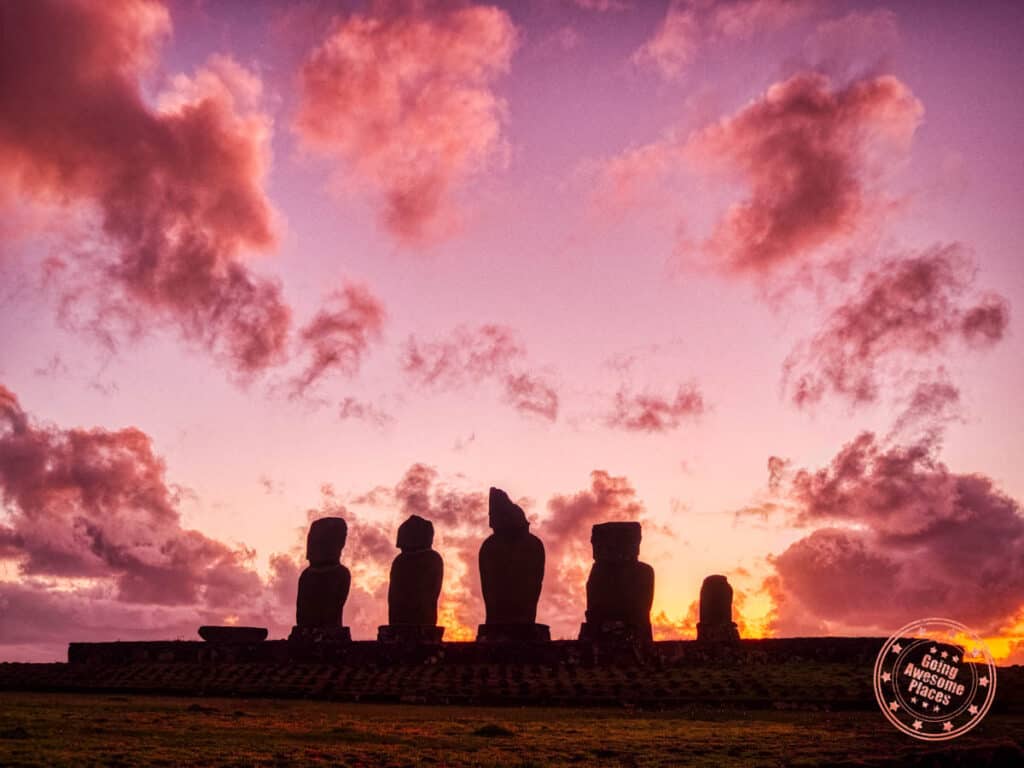
Thinking about a trip to Easter Island (perhaps as part of a full month in Chile), have it on your bucket list, or are in the midst of planning your visit? You’re no doubt wondering what exactly can you do on the island.
Despite being the most isolated island in the world and small in size, there are easily more than a week’s worth of things to see and do on Easter Island.
When we planned our trip, we were absolutely overwhelmed because we didn’t understand how we could go about seeing the moai heads on Easter Island (covered in our guide to visiting Easter Island) and also what else there was to do.
Instead of just giving you a massive list, we felt that it was appropriate to break it between the important archeological locations and activities you can do on the island.
This doesn’t include everything but for someone spending a week on Easter Island, these will keep you plenty busy.
Rapa Nui National Park
Rapa Nui National Park covers 43% of Easter Island and was created to protect the now 888 moai statues, over 300 ceremonial platforms, and other significant structures. It is also a UNESCO World Heritage Site.
However, unlike other National Parks around the world, there aren’t any specific entrance gates or a defined border. Instead, there are large and small sites scattered all over the island. They can be examples of petroglyphs on a rock near the coast that aren’t guarded or they can be a more significant site where tickets are checked and there are guards on site.
With the new rules, you can only visit the managed sites with a guide so the good news is that they will know exactly which archeological locations are worth visiting and in what order.
You’ll be amazed by the sheer size and scale of the tradition of carving moai as a way of honoring important members of the tribe. The plot thickens when you layer in stories about the mysteries of how they were moved and the eventual downfall of the civilization.
The below list of the best archaeological sites within Rapa Nui National Park will no doubt be the highlight of your visit to Easter Island.
9 Day Easter Island Itinerary
This seems to be a lot of time but in retrospect, 9 days ended up being the best way to see Easter Island. Get a day-by-day breakdown with this itinerary.
Easter Island Itinerary
1. Ahu Tahai

The area is simply called Tahai but Ahu Tahai is one of the most recognizable ceremonial complexes on Easter Island and is the most popular because it’s right in the town of Hanga Roa.
What most don’t realize is that there are actually 3 main ceremonial platforms (ahu) here – Ahu Ko Te Riku, Ahu Tahai, y Ahu Vai Uri.
There is also a well-preserved ancient village here and is said to be one of the oldest inhabited areas of the island. Your guide will be able to point out which were stone chicken-coops, base of boat-shaped houses, and gardening techniques.
This is also where famed Easter Island archeologist, William Mulloy’s tomb is located.
Pay attention to the solo moai here with its top knot and eyes. While these aren’t the original eyes, it is the only example outdoors that shows you how the sculpted megaliths were supposed to look like. The carving of the eyes and placing of the white coral was the last step, and what gave the moai life.
Being right in town, it’s one of two locations that don’t require a Rapa Nui National Park ticket to enter and is absolutely stunning at sunset. This means you can come here on your own and should be an easy walk from your hotel.
As the sun sets, grab a seat on the grass, and watch the sky turn into a symphony of vivid colors.
WHAT YOU NEED TO KNOW
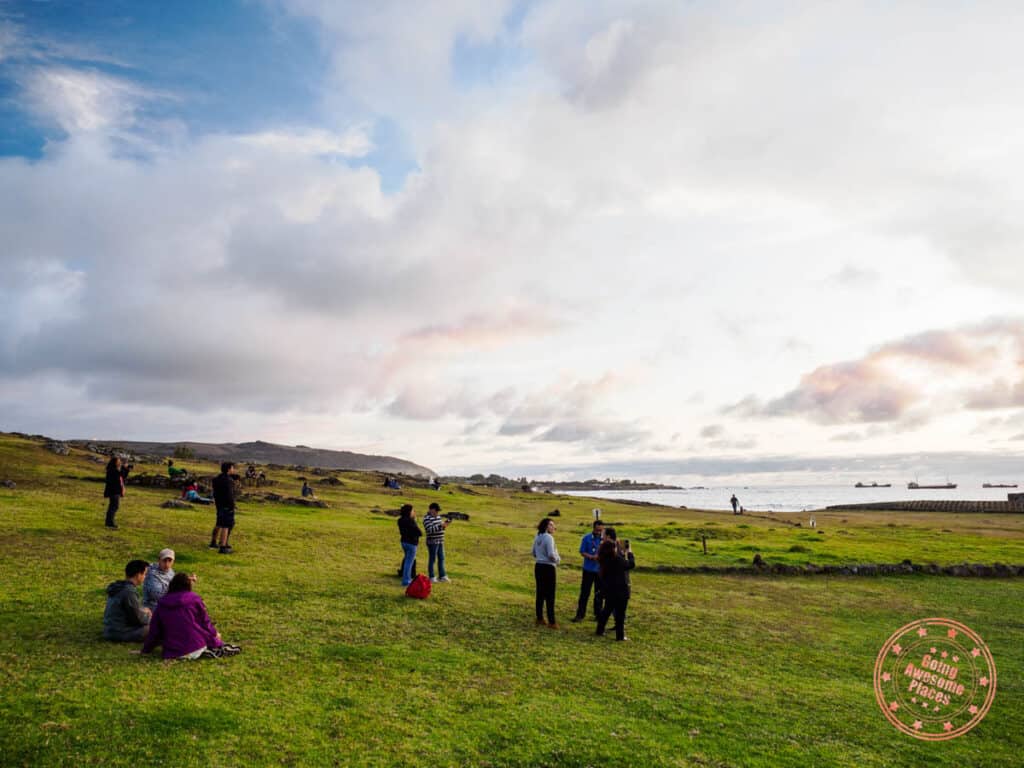

Managed: Yes. A guide is not required but there are guards patrolling the site.
National Park ticket required?: No
Best time to come: Sunset but day time is better if you want to see all of the archeological remains of the village.
Tips:
- At sunset, there are several vendors that set up inside the boundaries if you’re looking for cheaper souvenirs.
- The guards (called muto’i) watch the area like a hawk and will whistle at you if you break any rules, including accidentally walking into the restricted areas of the grass. Pay attention to the signs when exploring.
- If you’re into night photography, since Ahu Tahai is so easy to walk to, plan to come here one of the nights you’re on the island.
- Horses and stray dogs will be around but they’re harmless.
2. Rano Raraku

Most people that picture the moai of Easter Island are thinking about the sunken megaliths of Rano Raraku.
This is the legendary quarry where the skilled Rapanui workers chiseled the moai out of the volcano crater. Over time, soil covered up the moai that stood haphazardly on the volcano-side, leaving just the heads emerging from the ground.

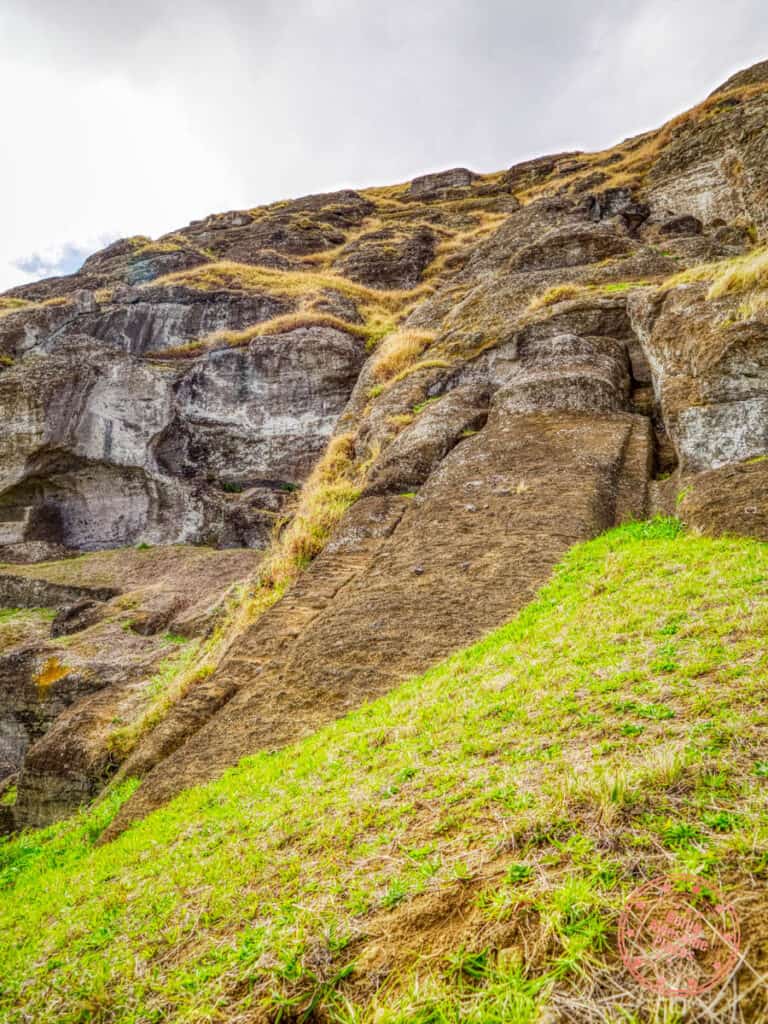
What’s fascinating about Rano Raraku is that it demonstrates the entire birthing process of the moai, with examples of half-carved stone still connected to the crater and unfinished moai partially carved. The hill and crater-side are literally littered with moai.
You’ll definitely want to spend more time here because there’s quite a bit to see as you walk through the hillside along the well-laid out path. There are also quite a number of photo opportunities here.
A heads up that National Park ticket holders can only visit here once and is definitely one of the more tightly guarded sites. You have to stay on the path and you can’t touch any of the moai.
Save Money with EcoChile

Looking for a packaged tour where you can be more hands off with planning and allows you to see all of the main sights? This 4 day Easter Island tour is an excellent option. This package includes accommodations, activities, airport transfers, entrance fees, and breakfast.
Save up to 5% – We’ve partnered with EcoChile to offer you 5% on all pre-packaged tours (not just Easter Island). You can also book a custom tour but the discount will vary. Simply put your inquiry through our form below!
3. Anakena

Anakena is a combination of many thing including a popular public beach, the restored Ahu Nau Nau with its 7 moai, and 4 with top knots, and Ahu Ature Huki which is where archeologist Thor Heyerdahl tested his theory of how moai were raised.


The story of this location is that some 1300 years ago, Polynesians first landed at this beach, thus creating the furthest outpost for these peoples, and the start of one of the most fascinating civilizations.
Ahu Nau Nau stands majestically, surrounded by sand, and has examples of the exquisite detail that were carved on the moai including their ears, nose, lips, hands, belly buttons, and back tattoos. This ceremonial altar is incredibly photogenic, especially with the beach, palm trees, and the wild horses that roam nearby.
The beach stays a comfortable 20°C (68°F) throughout the year, has incredibly soft white sand, and is in a protected bay, making it a great beach for all ages.
WHAT YOU NEED TO KNOW


Managed: Yes. A guide is not required but there are guards patrolling the site.
National Park ticket required?: No
Best time to come: Anytime during the day – depends on whether you’re coming here for the beach or for the moai. For the best light, come in the morning.
Tips:
- There are restroom facilities here (opens at 12PM). We’ve read that it costs $1 USD to use it but when we were here, all we saw was a tip bowl and no sign. This is the largest restroom out of all sites and frequently cleaned.
- Being on the north side of the island, it isn’t known for sunrise or sunset.
- There are fixed booths set up for local vendors. We didn’t find that these were any cheaper than the markets in Hanga Roa.
- There are horses that roam this area and if they are near the platforms, give them their space.
4. Tongariki
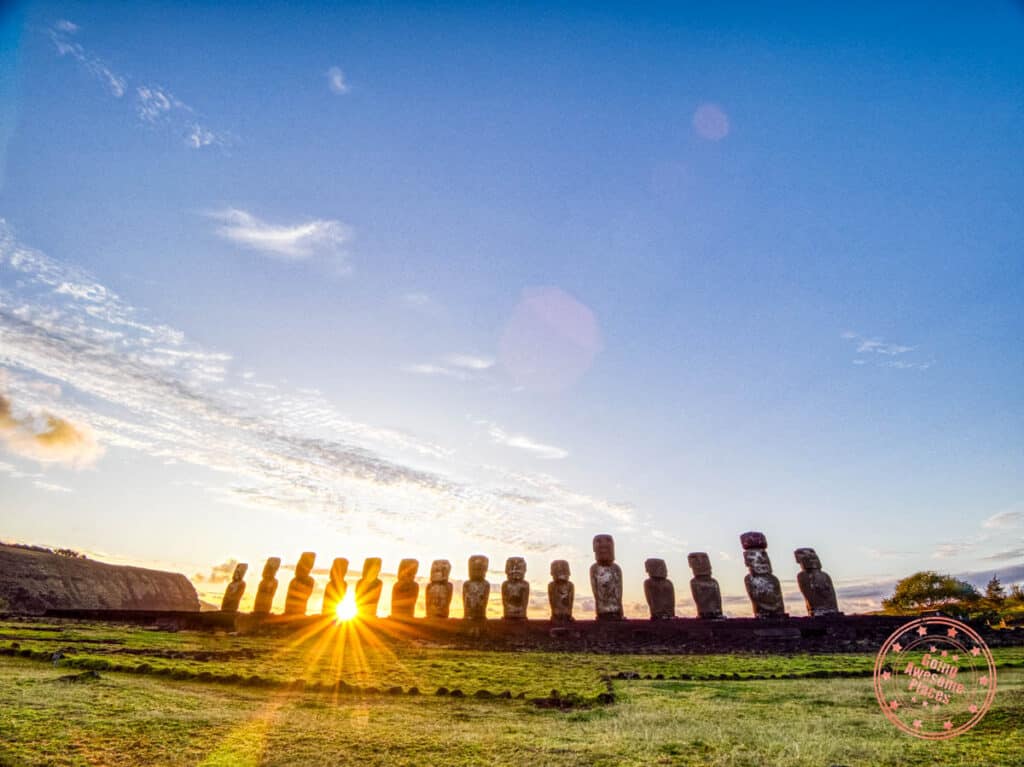
Tongariki is the name of the area and the largest restored ceremonial platform with a whopping 15 stone giants, is called Ahu Tongariki.
There are no words that can describe the sheer awe you’ll have in the presence of these sentinels that dwarf all of the other standing moai you will see on your trip to Easter Island.
Representing the pinnacle of the Rapa Nui stone carving period, this platform has a wingspan of 220 meters, features moai that range in all sizes and stature, and only one has a top knot.
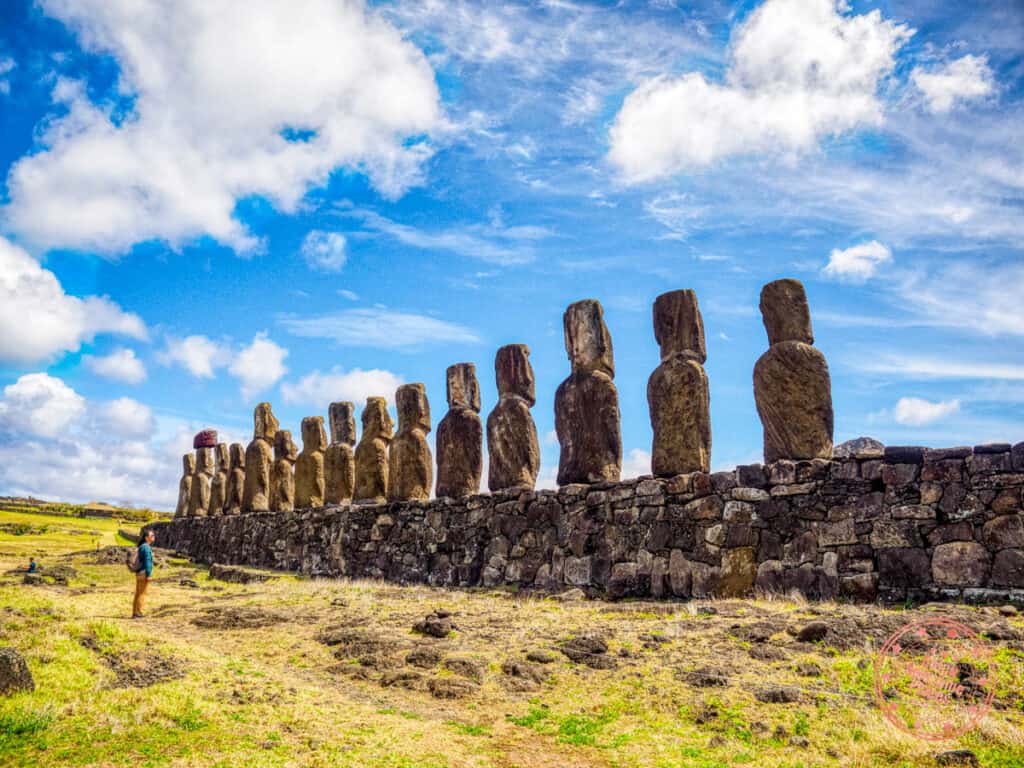
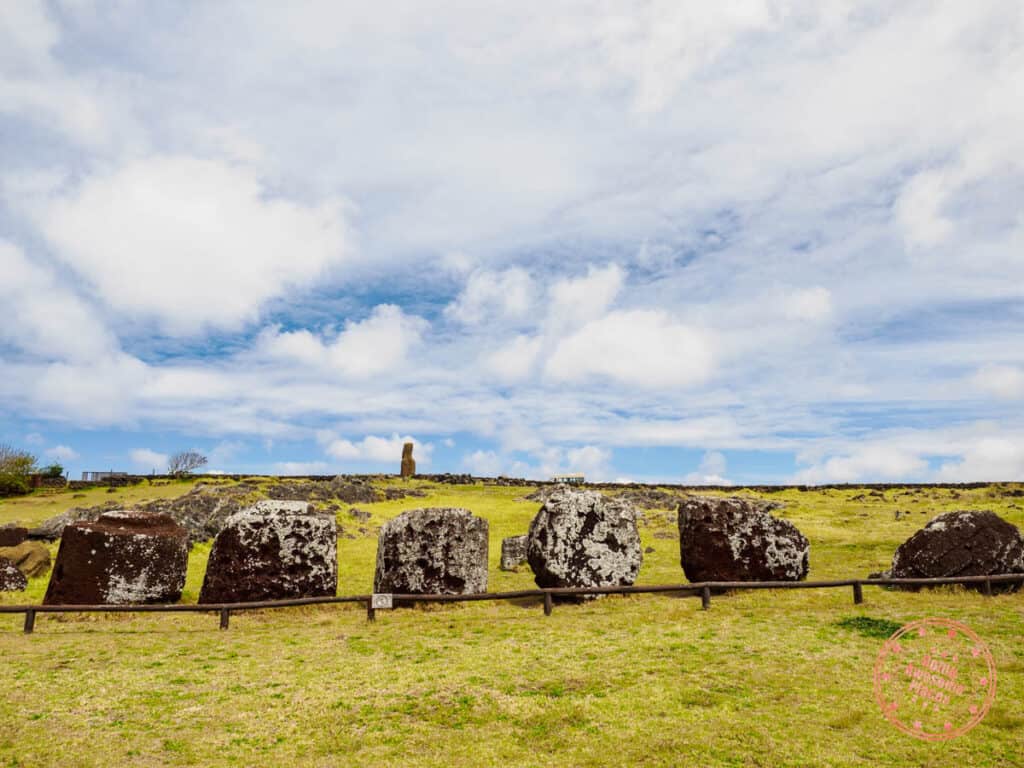

In addition to the 15 moai, there’s an excellent example of petroglyphs (rock carvings) at the back of the walled plaza, a fallen moai that was never finished, and a famed ‘Travelling Moai’ standing by the entrance, which was once in Japan.
Sunrise at Tongariki is also a popular thing to do on Easter Island. It’s quite magical to see the sun rise from behind the stone statues, creating a brilliant sun burst, while also casting mesmerizing shadows on the grass as it continues to rise.
WHAT YOU NEED TO KNOW
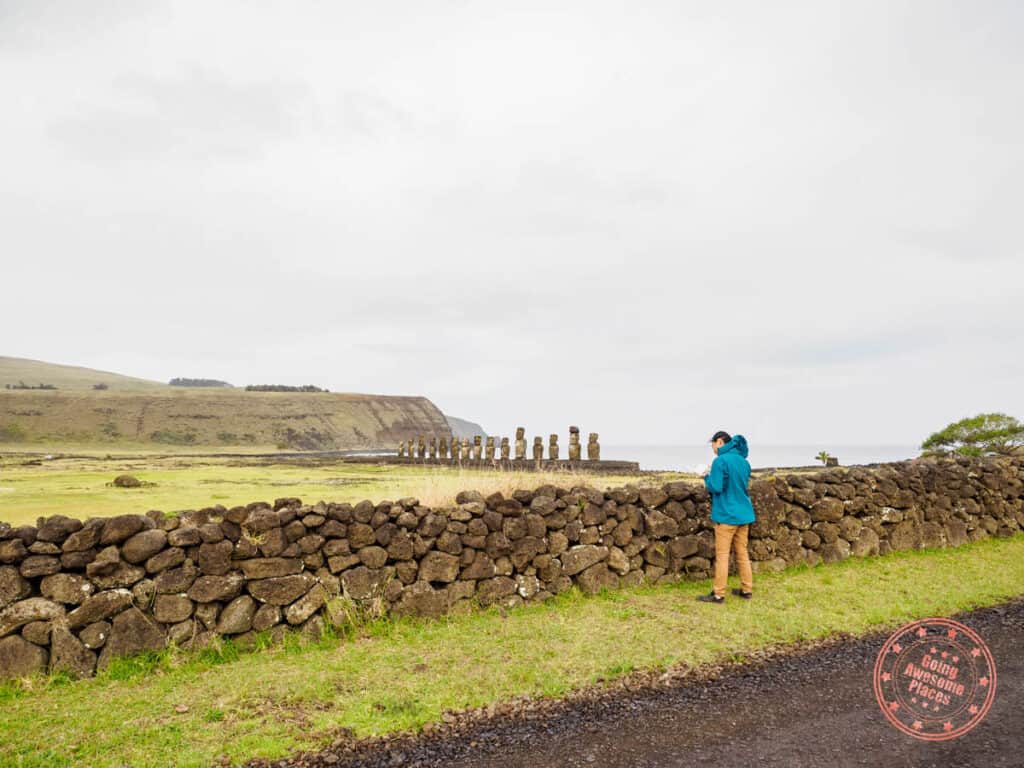
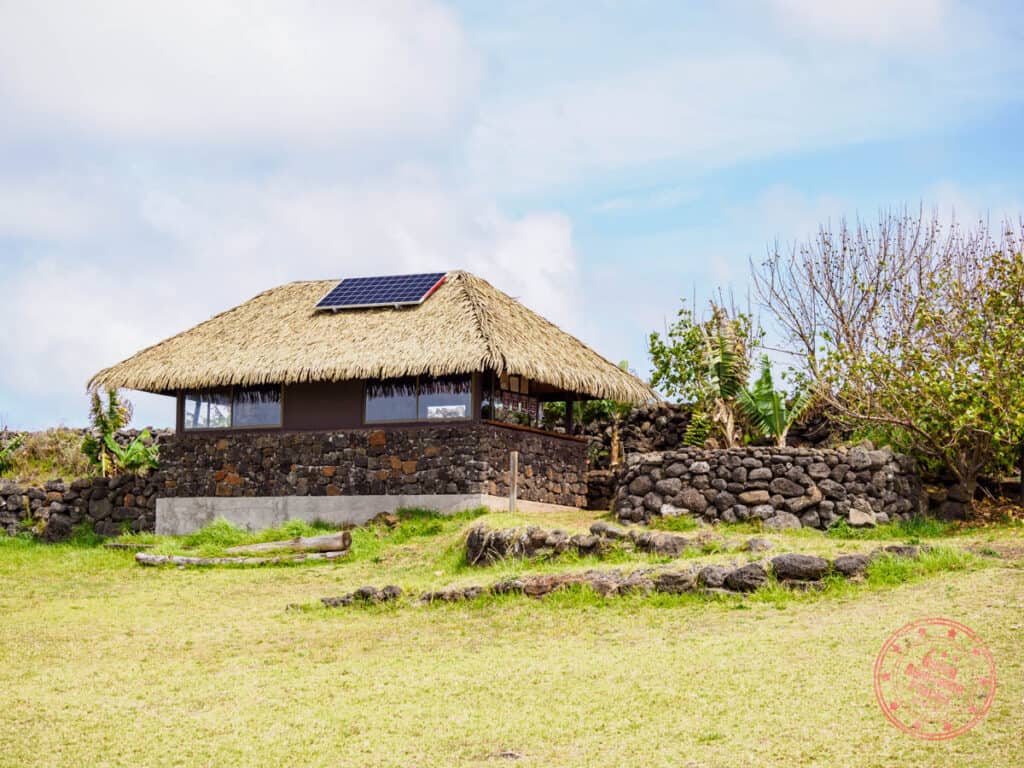
Managed: Yes and a guide is required.
National Park ticket required?: Yes
Best time to come: Sunrise or mid to late afternoon.
Tips:
- Horses can make their inside Tongariki as well.
- You actually don’t need to enter the official Tongariki boundaries (managed by the National Park) to see it. There’s a stone wall that surrounds it but your view isn’t obstructed so you can easily take photos from the outside.
- For sunrise, the sun doesn’t always align perfectly behind because it shifts throughout the year. You can ask your guide where it is or use an app like PhotoPills. Regardless, if you’re a photographer, be prepared to move around.
- A reminder that you can visit Tongariki multiple times (i.e. daytime and for sunrise).
- If you don’t have a guide for Tongariki sunrise, you can hang around the entrance and ask any one of the guides there to help you get in. Most of the guides are nice enough to do it especially if you’re already there.
5. Orongo

At the end of the 17th century, much of the structured society on the island had collapsed because of the depletion of resources. The age of the moai was over and in the chaos there was a social and religious revolution that lead to creation of the Birdman Competition.
The location of this competition centered around Orongo, a village perched at the edge of the Rano Kau crater. Each tribe would send a competitor to race on the chief’s behalf. The main challenge had them scale down the cliffs, swim 2km to Motu Nui, camp out in caves, wait for the first Sooty Tern bird eggs to be laid, and bring it back to the village with the egg intact.



Orongo is one of the top things to do on Easter Island because it has one of the most dramatic views – stunning views of the crater’s lush center, the Pacific ocean, and the nearby islets (motu).
When you visit, you’ll be able to walk through the ceremonial village has also been recreated with a cascade of 48 houses.
Lastly, this is the second site where you can only visit once which makes sense because the area is quite sensitive and is also exhibiting accelerated erosion. Take your time to savour the view!
WHAT YOU NEED TO KNOW


Managed: Yes and a guide is required.
National Park ticket required?: Yes and you can only visit once. They will cut out a corner of your paper ticket and write your information down (how they track it for digital tickets).
Best time to come: Early morning or mid to late afternoon.
Tips:
- There are restroom facilities at the visitor center which are the newest of all of the ones you’ll find in the National Park.
- At the very end of the trail, close to the ‘bite’ in the crater, notice the erosion and how dangerously close the final houses and petroglyphs. These are slowly slipping into the Pacific Ocean.
6. Puna Pau

While not as well known of a location as its quarry counterpart, Rano Raraku, Puna Pau is the quarry for the second part of the moai – the top knot or pukao.
Pukao is carved from red scoria stone, a soft volcanic rock. While intuitively, it looks like a hat for the moai, these were carved to represent how the men of that time tied their long hair in a bun.

When you come here, you’ll see how incredibly difficult it must’ve been to cut and carve the 12 tonnes of stone out of the quarry and then have it moved up and down the crater.
At the summit of the crater, you’ll also get great views of Hanga Roa.
WHAT YOU NEED TO KNOW


Managed: Yes and a guide is required.
National Park ticket required?: Yes
Best time to come: Anytime
Tips:
- There’s a steep walk up to the top of the crater to see the quarry itself. It’s short but you’ll feel it.
7. Ahu Akivi

You might be surprised to learn that not all ahu were built along the coast. Ahu Akivi is a prime example of one built further inland to look over a fairly large village. It consists of 7 moai and is somehow aligned with the spring and autumn equinoxes.

This is the first full platform excavation and restoration on the island by William Mulloy and Gonzalo Figuero in 1960.
Ahu Akivi is typically not very busy and with plenty of open space in front of the platform, it’s a great place to sit down and hear more stories from your guide.
WHAT YOU NEED TO KNOW
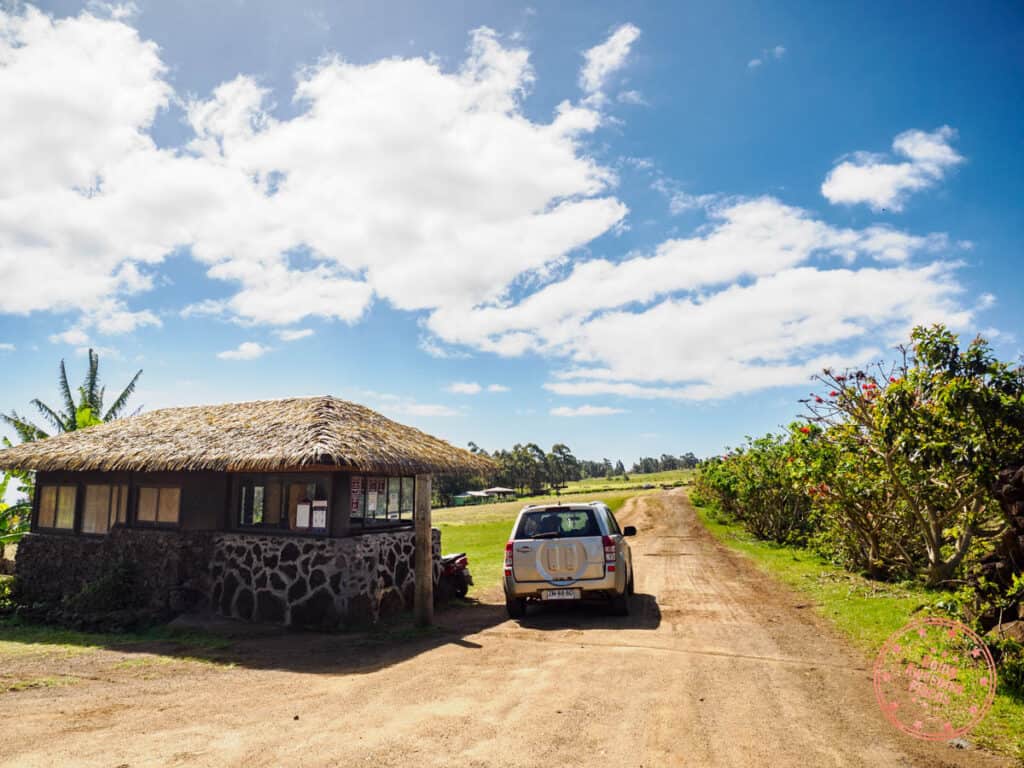
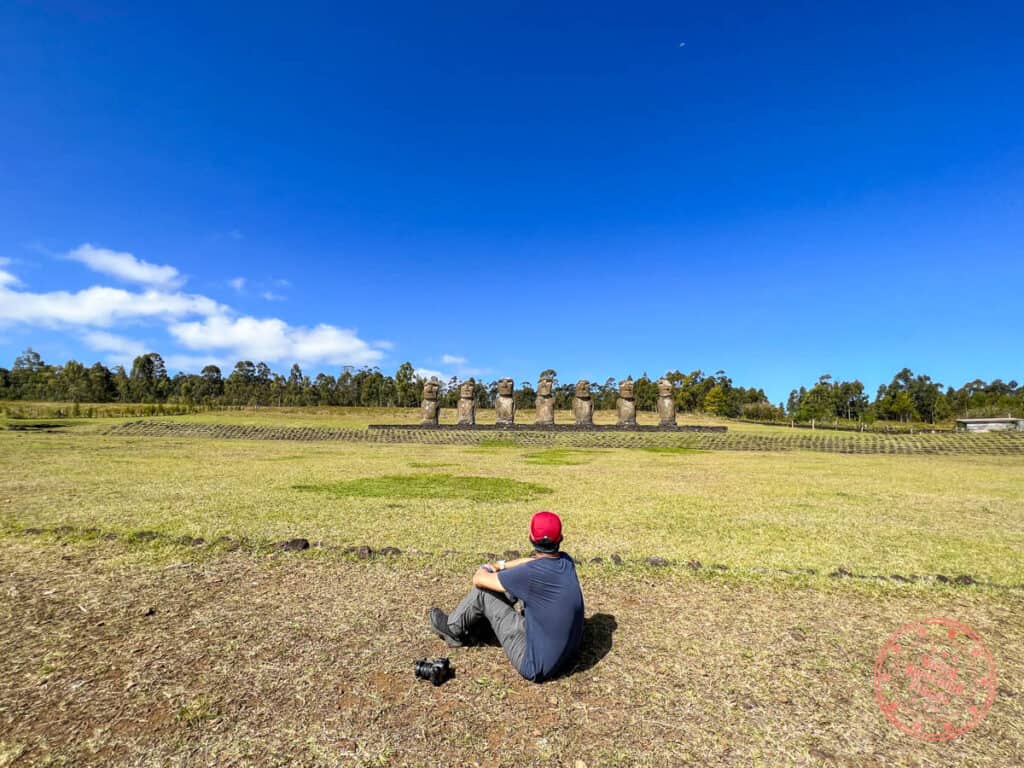
Managed: Yes and a guide is required.
National Park ticket required?: Yes
Best time to come: Mid to late afternoon.
Tip:
- This can be a quick visit if you’re on tight on time as it’s mainly the moai you’re here to see which is also right next to where you park your car.
8. Te Pito Kura

This is another archeological site on Easter Island that is popular for day 1 or day.
If you’re interested in seeing the largest moai to have survived transportation from Rano Raraku and then lifted to stand on Ahu Te Pito Kura. This moai measures 10m tall and weighs in excess of 70 tonnes.

In this area, you’ll also encounter a large circular stone surrounded by 4 smaller stones. Legends have it that the island’s first king brought it to Easter Island because it was endowed with mana. Another name for this is ‘Navel of the World’.
WHAT YOU NEED TO KNOW
Managed: Yes and a guide is required.
National Park ticket required?: Yes
Best time to come: Anytime
9. Ahu Akahanga

Not all ceremonial platforms have been restored. These platforms and moai are in situ and give visitors a sense of Rapa Nui’s turbulent past. It’s a reminder that tribal wars and famine lead to huge conflicts and backlash against the moai.


Fallen moai are also how the early European explorers would have seen the island when making landfall. This means that they haven’t been moved for 300 years.
In addition to the moai, you’ll find small caves here that were used as cooking areas, and foundational stones for boat houses.
In addition to Akahanga, there are numerous in situ platforms and moai around the island. Other notable ones are Ahu One Makihi (near the side of the road), and Ahu Hanga Te’e in Vaihu.
WHAT YOU NEED TO KNOW
Managed: Yes and a guide is required.
National Park ticket required?: Yes
Best time to come: Anytime
Our story:
- On our free day with our car rental, we noticed that there was an open gate in the road by the coast. We drove in and were nervous that we weren’t supposed to be there so we turned around. We later went to the official entrance to Ahu Akahanga and noticed there wasn’t a guard at the booth. We walked in to take a look and shortly after, out of nowhere, a guard drove in with their motorcycle. The interest thing was that he was actually incredibly friendly and was trying to get us to pay him to be a guide. This is gives you a glimpse into the consistencies in how some sites are managed and the motivations of some guards.
10. Vinapu
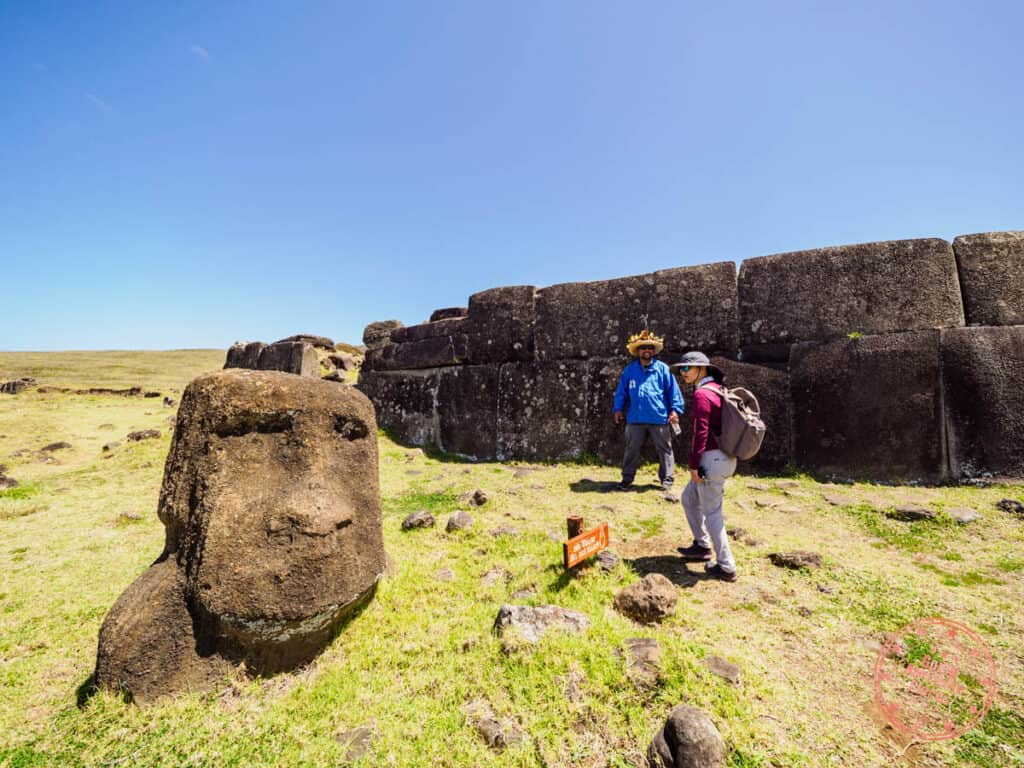
Easter Island is filled with mysteries and one that you won’t expect is a connection between the island and South America.
In the Vinapu sector is Ahu Tahira. When you first arrive, you’ll notice the 6 overthrown moai with their top knots not far away. To the left is also a rare moai carved entirely out of red scoria stone and has a pronounced belly button.

What’s even more interesting is what you’ll see when you get to the back wall of the platform. This shows just how advanced the masonry had become on Easter Island.
There is an uncanny resemblance to the stone work you’ll see in Peru and Cusco in particular (see our 2 week Peru itinerary). This begs the question, how much contact was there between the Rapanui and the Incans? Is there a connection or are there only so many ways to build a good wall out of stone?
What about the half-buried moai? By its crude carvings, scientists say that this was from an earlier period and was likely broken or rejected and simply left there.
WHAT YOU NEED TO KNOW
Managed: Yes and a guide is required.
National Park ticket required?: Yes
Best time to come: Anytime but they are known to have great sunrises and light in the morning.
So How Do You Get To Easter Island?
There’s the simple answer but as someone that’s been, there are a lot of small details that we share including a flight hack that’ll save you a ton of money.
Guide For How To Get To Easter Island
Activities Beyond Moai
Going beyond feeling like a modern day Indiana Jones or Lara Croft, exploring ahu and moai, what are some of the other things to do on Easter Island?
Here is a continuation of our list with inspiration for other type of activities and attractions you’ll find here.
11. Hiking on Easter Island

One of the popular things to do on Easter Island is hiking. There are several to choose from that’ll give you a true feel for the serenity and calm of life on the island.
With the gentle terrain, these can be classified as easy to moderate walks so don’t expect anything intense like what you’ll find in Torres del Paine, Patagonia.
To do these hikes, you can either use your own rental car, do it as part of a guided tour, or have something coordinated with a taxi. Many of these trails are one way, and some aren’t the most well-marked, or in the case of the North Coast, not at all.
- Terevaka (4 hours, 9 km) – Walk to the summit of the island’s tallest point. There’s a trail that starts near Ahu Akivi and another midway along the NASA-paved road. You can also turn back on the same way you started. This one you can easily do without a guide.
- Via A Tare Crater (2 hours, 5km) – Walk the eastern rim of the volcano creator. You can start all the way in Hanga Roa or there’s a gate that you can park at further up. It’s possible to do this without a guide but make sure you have an app like AllTrails to help with pathfinding.
- Poike (5 hours, 11km) – This is a full day that allows you to explore the northeastern part of the island that’s been closed to vehicles since 2005. You’ll be able to hike up to the summit of Pua Katiki, discover small moai that dot the peninsula, and see a part of the island that visitors rarely get to see.
- North Coast (5-7 hours, 13.5km) – Another full day hike that takes you through the most untouched part of the island that is filled with archeological discoveries. This is a one way hike that eventually ends at Anakena Beach. We did this as part of our 9 day Easter Island itinerary and would highly recommend it. Having a guide is a good idea.
12. Relax on the beach

There are two main beaches on the island. While most will gravitate towards the easily accessible Anakena Beach, the locals favor Ovahe Beach because it’s much quieter and feels more off-the-beaten-path.
Choose Anakena Beach if you want to be close to wide open beach, restroom facilities, beach restaurant (called Anakena Hopu), souvenir shops, and moai.
The distinct advantage that Anakena has over Ovahe is that it’s much more spacious and it’s more wide open, receiving sunlight throughout the day.


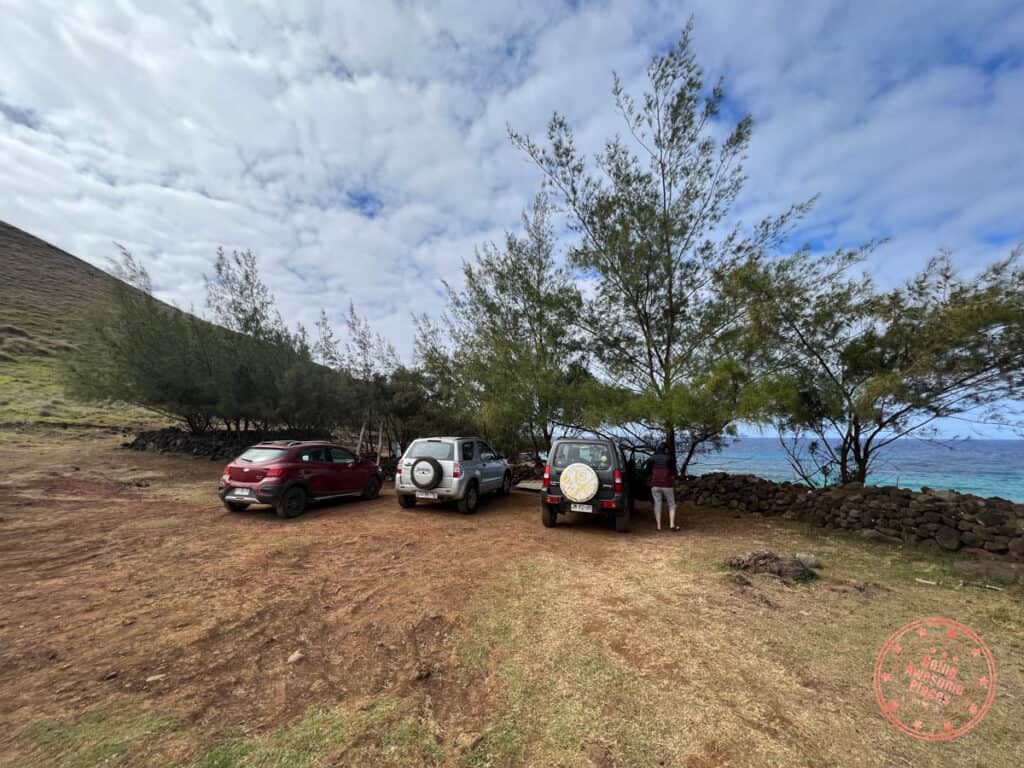
Choose Ovahe Beach if you want to get away from crowds where you can lay out your beach towel near volcanic rock and enjoy a more tranquil experience. There are actually two beaches here, with rock that divides the two.
The downside is that there are no changing rooms or bathrooms at this beach.
TIP: For Ovahe Beach, make sure you have good footwear as you’ll need to traverse through a path that is quite rocky. Also, the sun gets blocked in the late afternoon (3PM in October) by the cliff behind so we recommend that you come here early.
Thinking About 1 Month in Chile?
If you’re looking to go beyond just Torres del Paine and Patagonia, we have you covered with our practical month in Chile that covers Atacama, Santiago, and Easter Island as well.
1 Month Chile Itinerary
13. Visit the only museum on Easter island
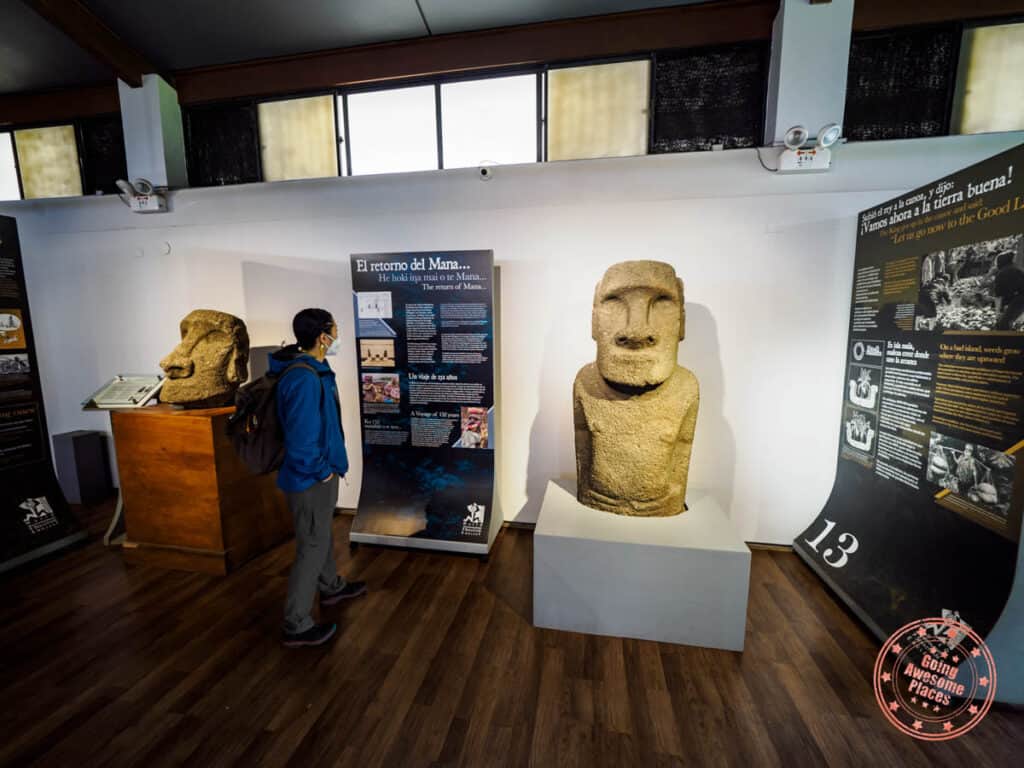
The official name of the museum is Father Sebastian Englert Anthropological Museum, located on the north side of Hanga Roa and also conveniently a short walk from Takarua Lodge.
This museum and its permanent exhibit dedicated to telling Rapa Nui’s story may look small but can’t be missed in our books.
Whether you’ve soaked in as much as you could through your guides or are coming in green, you’ll be able to learn through the exceptionally well laid out numbered panels that have Spanish and English. Each panel is quite large and does a great job of integrating archival photos and illustrations.
In addition, the museum houses a number of unique artifacts that you won’t find elsewhere including an authentic example of white coral used for the eyes of the moai, the only example of a female moai, carving tools, and more.
Oh and guess what, it’s free! Just remember it’s closed on Mondays.
The anthropological museum with its permanent and temporary exhibits is just one part of Mapse, the broader organization that consists of a library, laboratory, storage, and administration.
TIP: The museum’s own book titled ‘Los Ancestros de Rapa Nui’ is more or less a verbatim copy of the museum’s displays. If you’d like to bring it home for reference, this book has Spanish and English and makes for great reading on the island.
WHAT YOU NEED TO KNOW
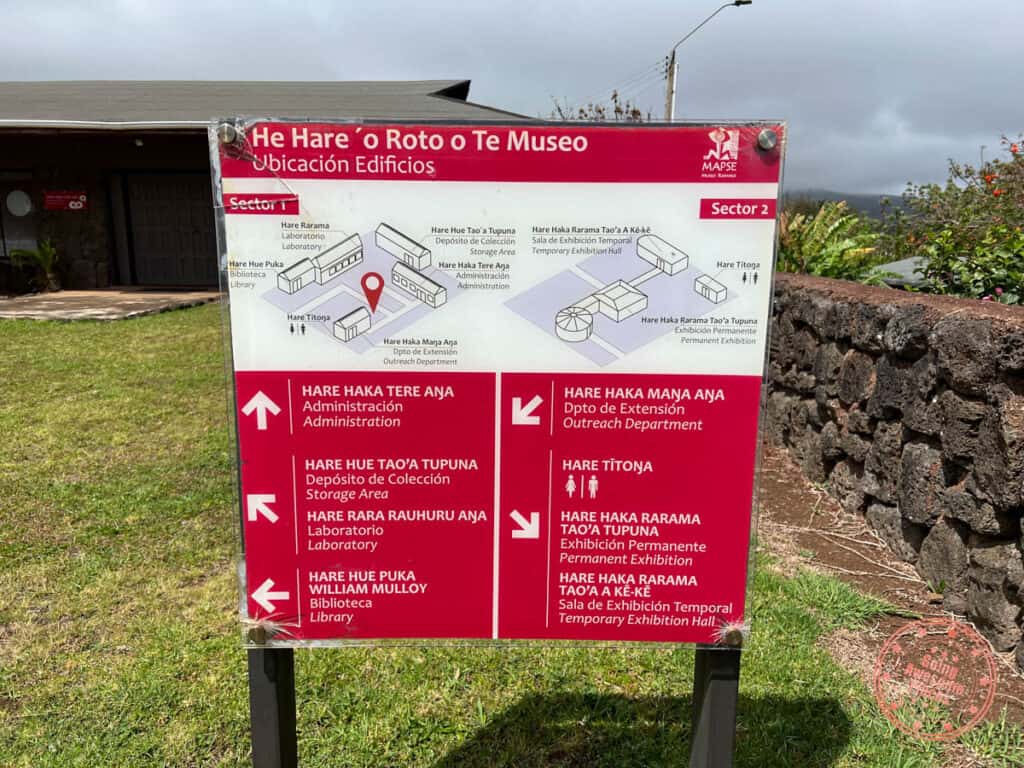

Hours: The official hours are posted on this page.
- Tuesday to Friday : 9:30AM to 5:30PM
- Saturday, Sunday and holidays : 9:30AM to 12:30PM
Price: Free
Tip:
- They offer guided tours of the permanent exhibit for groups of 5-15. Reservations are made via phone or e-mail. This is likely Spanish-only.
- If you’d like to visit the library, they are open Monday to Friday 9:30AM – 1PM and 2PM – 5:30PM.
14. Catch a traditional Rapa Nui show

Even if you’ve seen traditional Polynesian shows in say Hawaii (called a luau) and French Polynesia, or Maori cultural experiences in New Zealand, it’s worth going to one of the Rapa Nui shows in Hanga Roa during your stay.
These are high-energy, sweat dripping, hip-swaying dances that are an authentic way of seeing local Rapa Nui culture especially if you aren’t lucky enough to be here during the Tapati Festival.
There are two companies that offer traditional Rapa Nui performances. They are both quite similar and have similar offerings of dinner or general tickets.:
- Kari Kari (W, F at 8PM, 1 hour) – $30,000 for general ticket, $85,000 with dinner (at Ma’aranui Native Restaurant Bar)
- Te Ra’ai (M, W, F, S at 8:30PM, 1 hour 15 minutes) – $35,000 for general ticket, $72,000 with dinner (traditional umu ceremony, face painting, buffet style)
In both cases, you can book online but if you’d like to be a bit more flexible, you can totally buy tickets on the day of where you can pay by cash or credit card (in CLP).
Ultimately, Kari Kari seemed to be the consensus of which show is the best when we talked to locals and it’s also cheaper as well. That said, the dinner option at Te Ra’ai is much better and they have more shows in the week.
If you can, make sure you fit this into your Easter Island plans.
TIP: At Kari Kari, they offer tickets for first row and second row which in our opinion isn’t worth the extra cost, especially if you end up going on a day when it’s relatively empty. On those days, you can sit anywhere you want. Oh and a word of warning – if you’re sitting in the front, expect to be called out to the stage!
15. Go scuba diving
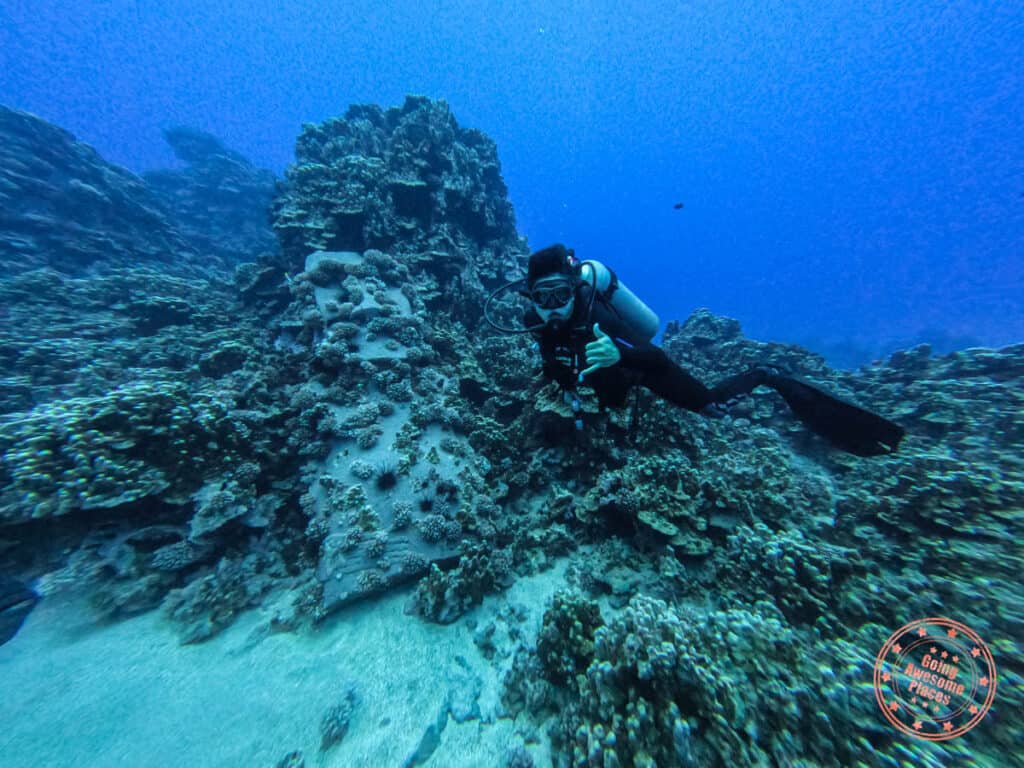
Easter Island isn’t necessarily known for its scuba diving but it has the advantage of having some of the highest clarity in water, an abundance of marine life that you’ll find in most of the Pacific Ocean, and even a moai.
It’s the sunken moai that attracted us to diving in Easter Island in addition to feeling the serious itch since our incredible dives in French Polynesia. Despite knowing that it’s a moai prop from the movie Rapa Nui, it’s still one for the scuba-enthusiast’s bucket list.
The truth is, we thought the diving itself wasn’t extraordinary. We got our photo-op in front of the moai and the rest wasn’t the most memorable as the moai dive site isn’t known for its coral and marine life. It’s mostly hard coral and you won’t find the most colorful fish here.
That said, they do offer other dive sites such as Motu Nui (one of the islets), Cathedral (lava tube), and Acantilado (cliff dive).
While the water temperature stays consistent throughout the year, we’re not talking about tropical diving. It stays at 18°C (65°F) so it’ll be a bit more chilly than you’re used to. This means that you’ll want to use a full-length 5mm wetsuit.
There are a number of dive shops on Easter Island but I was disappointed with how difficult with how it was to communicate with them. We tried Facebook, Instagram, email, and WhatsApp but it was a challenge getting more information about how they operated and their pricing. Websites were either non-functioning or terrible to navigate.
Here are the main companies we considered:
It’s a bit of a disaster if we’re being honest and so ultimately we don’t recommend booking anything online in advance. When you arrive on Easter Island, walk over to the row of dive shops in the Hanga Roa Harbour which includes Mike Rapu, Orca Diving Center, and Rapa Nui Dive Center. From there, you can speak to them in person and find out their details.
Tortuga and Atariki are located by the large commercial harbour on the south side of Hanga Roa which makes them a little more inconvenient to get to.

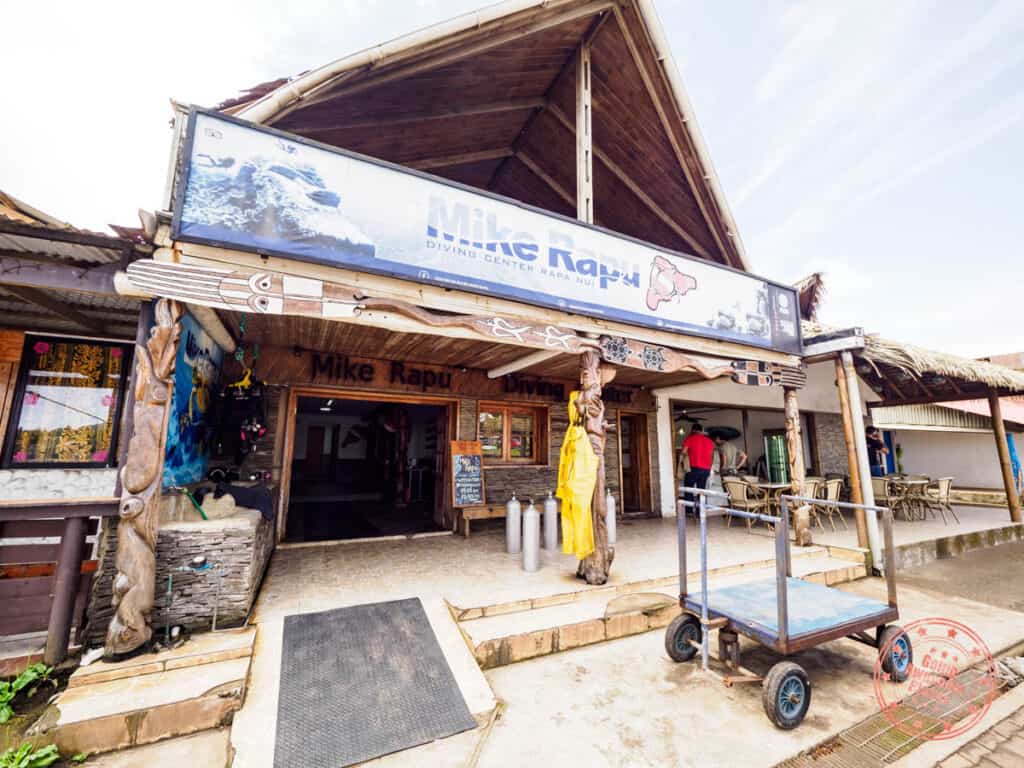









For us, we ultimately picked Mike Rapu because they were the largest shops that were actually open. Here’s how they work and a few other notes of what we learned from our Moai Dive experience.
- Their website and e-mail auto-responder are not updated with the current information and the website has broken links all over.
- As of October 2022, their dive shop hours are 9AM to 5:30PM. On Saturdays they are only open until 1:30PM. They are closed on Sunday.
- Their WhatsApp number is +56-9-9306-1928 where you’ll have much higher success in getting a response.
- Scuba diving is current and wind dependent and only operate when the waters are calm.
- Most dives leave in the morning (8:45AM departure and estimated 10:30AM return) but they sometimes will do a 2:30PM.
- Dives cost $45,000 CLP ($55 USD) and this includes equipment rental. A heads up that they don’t provide dive computers so you’ll be simply following your guides.
- If you don’t have a diving license, Discovery Dives are $55,000 CLP ($67 USD).
- They offer photography for $5,000 CLP per person but you need to bring your own SD card, MicroSD with SD card adapter, or USB key in order for them to transfer it to you.
- To secure a dive booking, you have to pay a $10,000 CLP deposit per person.
- They accept payment by cash or local e-transfer.
- They expect your previous dive to be within 6 months, otherwise they will insist on a refresher course.
- They have closed and open fins so if you have a preference, make sure to ask.
- They have men and women’s change rooms, lockers (not lockable), showers, and bathrooms at the dive shop.
- The moai dive is only a 10 minutes ride away in a small wooden boat with 3 rows and equipment placed on the floor. Entry is back roll.
- Expect choppier waters since you’ll be in the Pacific Ocean versus a calm lagoon.
- Bring your own waterproof bag for the boat. Bring any equipment you need for the dive including camera. You’ll be leaving your street clothes, towel, and bags in the dive shop in the change room lockers.
- Overall, we found that they are incredibly informal when it comes to checking documentation, equipment checks, briefing (done after entry into the water). They’ll make sure the equipment is safe and help you put it on but at the same time, you’re also kind of on your own.
- They also offer boat rides to the motu that include snorkeling for $20,000 CLP per person.
- Overall, it did not seem to be the most organized dive shop and had mixed reception to English.
Let’s just say that we did the one dive to see the moai and didn’t do any more during our 9 day itinerary.
16. Go stargazing
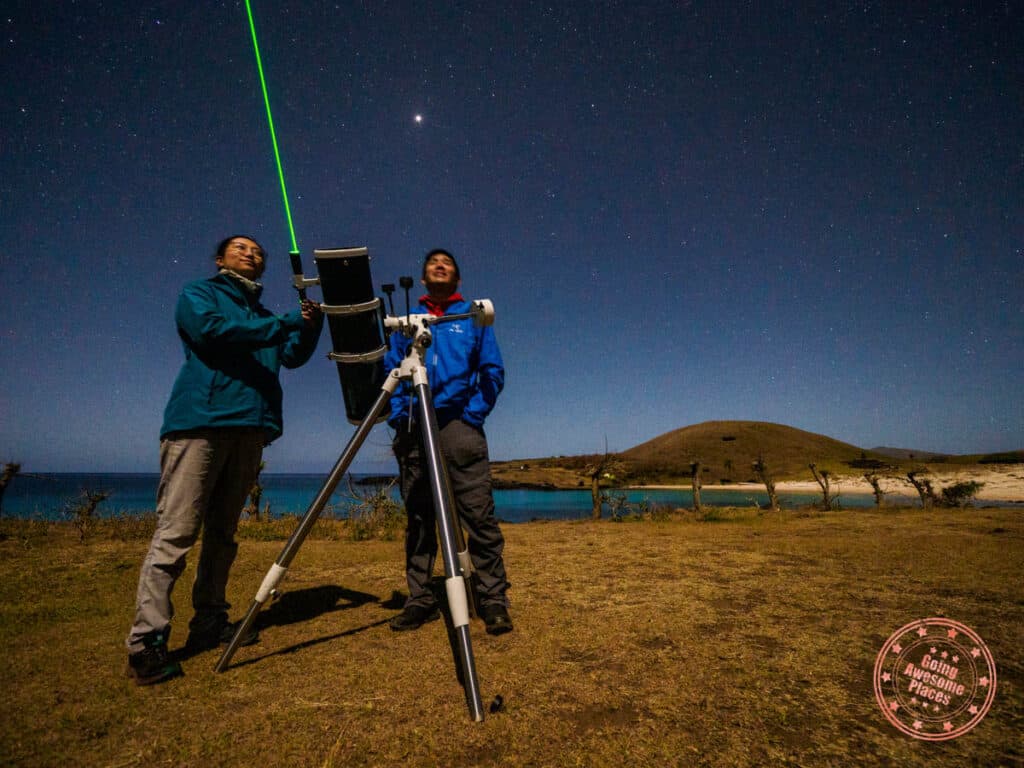
While not necessarily something that Easter Island is best known for, Easter Island’s remoteness and lack of light pollution is a good recipe for seeing the night sky.
When you add the mystical wonder of the moai, you also get a once-in-a-lifetime opportunity for some of the most dramatic astrophotography shots.
The only downside is that the weather can be quite unpredictable on Easter Island especially when it comes to cloud cover. As a result, stargazing won’t be as good as what you’ll have in your Atacama itinerary, but it’s definitely a fun activity to do.
If you’re looking to do this, you can of course do it on your own but if you’d like a guided experience where you can learn about the stars in the southern hemisphere and use high powered telescopes, Green Island Tours offers one of the few stargazing and astrophotography tours.
TIP: If you’re interested in stargazing, check to make sure you’re there in and around a new moon. A full moon is a bad thing because it brightens the sky too much.
PRO TIP: If you’re an astrophotography pro, we probably don’t need to tell you this, but make sure to use PhotoPills to figure out whether the Milky Way lines up with what you want to shoot. There are definitely better times of the year to go than others.
Which guide did we use?
We did quite a bit of research for who was the best private tour company on Easter Island and we loved the energy of Marc Shields from Green Island Tours Easter Island after seeing his YouTube channel and the rave reviews.
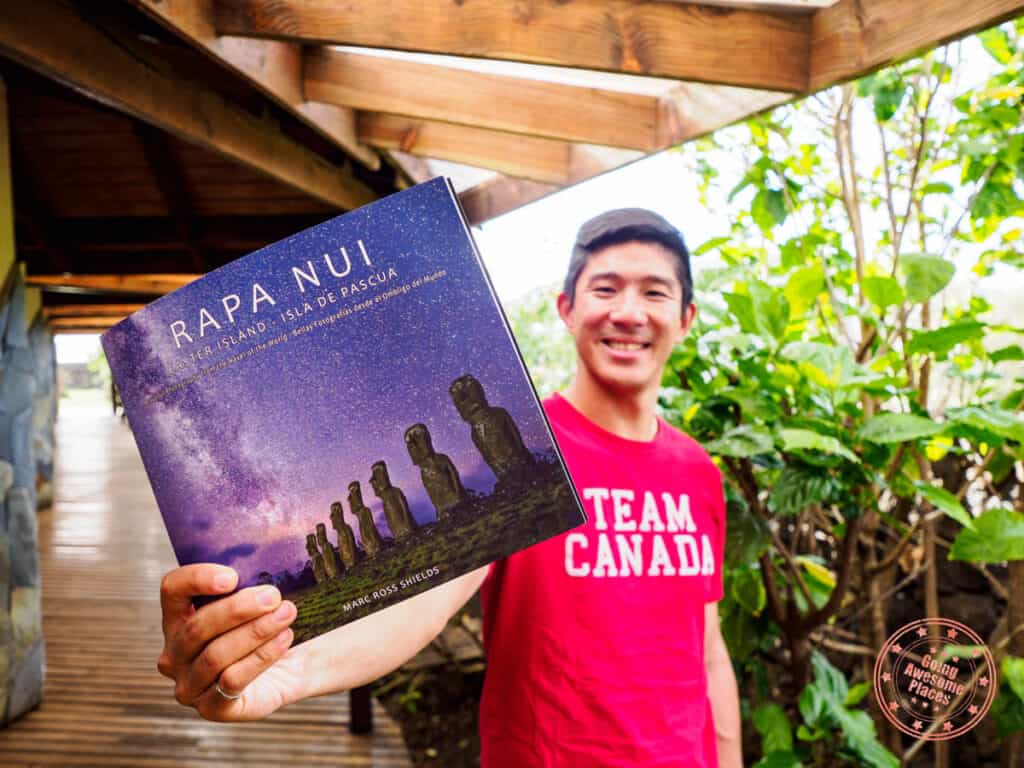
Special offer – Mention “Going Awesome Places” when you book your tour and get Marc’s photography book (sells for $35,000 CLP at the airport).
17. Hop on a boat to see the motu

From Orongo you can see how far competitors needed to swim to get to the motu (sometimes called Birdman Isle). What if I told you that you could go on a boat tour to see these motu off Rano Kau and their seabird colonies upclose?
Most operators that offer this tour know a fisherman that can take there guests out there. This is typically a 2 hour experience.
18. Discover the caves of Easter Island



One of the major things to do on Easter Island that’s part of the tour circuit are the natural caves around the island. The one that’s the most popular is Ana Te Pahu but that’s just one of many that you can visit.
Created from lava that flowed through here and eventually cooled to turn into a labyrinth of caves, there are natural openings from where the lava tubes collapsed, allowing you to enter in and explore as Lara Craft would.
Ana Te Pahu is also called ‘Banana Cave’ because of the large number of trees that were planted here by inhabitants, creating an oasis grove sprouting from underground.
Other caves worth mentioning are Ana Kai Tangata which has well-preserved wall paintings inside, and Ana Kakenga which is where the lava tube exited into the ocean, creating picturesque windows. There are also quite a number of them along the north coast hike.
HEADS UP: The cave ceiling stone is unstable at Ana Kai Tangata which is why the Rapa Nui National Park no longer promotes this site. The stairs down are still accessible but be careful.
19. Get a special stamp in your passport

This is a bit of a novelty, but like you can get souvenir passport stamps in other parts of the world, like One Foot Island of Aitutaki in Cook Islands, or when visiting Machu Picchu, you can also get a Rapa Nui stamp.

Contrary to older guides, they’ve now moved the stamp from the post office (CorreosChile) to the Tourism Information Office (SERNATUR).
Ask them for your stamp and they’ll bring it out for you to use. Before you do so, make sure you educate yourself on the risk of putting a stamp like this on your passport.
20. Spot turtles in the Hanga Roa Harbor

Right at the Hanga Roa Harbor where all of the colorful boats are, it’s quite common to spot sea turtles swimming about.
You’ll find yourself completely mesmerized as the current pulls the turtles back and forth in the water and the look for food.
In the summer, some people even go snorkeling here to be able to swim near the turtles.
It’s the simple joys on Easter Island and one of the many great things to do on Easter Island.
21. Explore Hanga Roa

The town of Hanga Roa is where you’ll be spending your free time and evenings roaming around. It’s a tidy little town that’s easy to explore on foot.
Over the course of your visit to Easter Island, you’ll start learning where the main streets are in Hanga Roa. The main street of town is Atama Tekena and the other is Te Pito O Te Henua that runs perpendicular it and goes from the church down to the harbor.
The town is primarily bordered by the cemetery, the Hanga Roa Harbor, the largest pharmacy (Cruz Verde), the church, and our favourite empanada spot (Panaderia y Pasteleria Hitu) on the main street of Atama Tekena.
There are plenty of souvenir shops, restaurants, markets, bakeries, and services in Hanga Roa.








While small, there are plenty things to do in Hanga Roa. Here’s a few places that you should consider checking out:
- Cemetery – This is the island’s first cemetery and is now completely full. Pay attention to the red cross in the middle which is carved from an old top knot.
- Hanga Roa Harbor (also known as Fishermen’s Wharf) – This is where the main dive shops are located but is also a great area to spot sea turtles swimming about and local kids fishing. There’s also a great restaurant and ice cream store here.
- Estadio Koro Paina Kori – This is the local community center and a giant soccer field. You’ll pass by here frequently, giving you a sense of what life is like for the kids on the island.
- CorreosChile – This is the island’s only post office and where you’ll want to go to buy stamps if you’re mailing any postcards.
- Feria Artesanal and Mercado Artesanal – These are two separate souvenir/handcrafted goods markets. The former is easier to get to and connected with the National Park office while the latter is a bit further out and near the church.
- Church of the Holy Cross (Iglesia de la Santa Cruz) – A beautiful church that has both Christian and Rapa Nui motifs on the outside. The best time to visit is the Sunday morning service at 9AM.
- Pea Beach – This is a surfing beach, natural swimming pool (great for kids), sunbathing spot, and sea turtle spotting area. Another natural swimming pool area is Hanga Vare Vare. Both have public showers for rinsing off.
- Tourism Office (SERNATUR) – This is where you can get the special stamp and ask questions you might have about seeing the island. Like many things on the island, their hours (M-F, 9AM-1PM, 3PM-5PM) aren’t the most accurate.
22. Go horseback riding

There sure are a lot of horses on the island and you’ll see plenty of them in Hanga Roa and near many of the major sites in Rapa Nui National Park. While they roam freely, many of them do have owners.
A popular thing to do in Easter Island as visitors is to go on horseback riding tours as a way to see a completely different side to the island.
The tours cater to different skill levels but two main companies that offer them are:
- Adventure Terevaka – They have an amazing horseback riding tour that goes up to the summit of Mount Terevaka where you’ll then plant a eucalyptus tree. We absolutely love this being regenerative travel experience. For intermediate and advanced riders, they also have another one that goes to the north side of Mount Terevaka to check on the wild horses.
- Kava Kava Tours – They offer a 3 hour tour that also summits Mount Terevaka.
TIP: Make sure to wear full pants and not shorts when going horseback riding.
Everything You Need To Know About Travel to Easter Island
No detail is spared. This is the must-read Easter Island travel guide. Thank us later 😉
Visiting Easter Island Guide
Final Thoughts
This trip to Easter Island was reminiscent of our trip to Egypt but also completely different at the same time. That’s why we call it a tropical archeological expedition.
As it should be, the focus of any trip should be on the history of Rapa Nui and the rise and fall of the all-out obsession of carving moai. There is so much to uncover and with the help of local guides, you’ll be able to see all of the top sites.
At the same time, there is also a nice balance of other activities you can do on the island but it’s mostly pretty low key.
This list of 22 best things to do on Easter Island shows you really do need a week or more to do it all. Hopefully this serves as plenty of inspiration for your future trip!
Remember, check out our full Easter Island travel guide that has essentials and secrets that you need to know before you go.
Frequently Asked Questions
The first moai platform to be restored was Ahu Akivi.
The largest unfinished moai is still on the hillside of the Rano Raraku quarry. The tallest moai to be standing is the fallen one at Ahu Te Pito Kura.
The statues on Easter Island are called moai (pronounced: “moe-eye”) and they were carved as a way to honor important clan members as a way of watching over the tribe.
There are a total of 888 moai on Easter Island including 398 at the Rano Raraku quarry, 288 were erected on ceremonial platforms, and 92 left enroute.
Yes, you can go scuba diving around the island. There are several dive shops on Easter Island to choose from.
Unfortunately, no. There are many theories, but the most likely one is that this was a prop from the movie Rapa Nui.
Important factors to consider are: price, English-speaking, storytelling skills, photography skills, private vs public, ability to customize, and wide range of tour.
The consensus from locals is that the Ballet Kari Kari show is the best one.
What you should read next
Travel Resources For Your Next Trip
If you’re in the process of planning your trip and putting together your itinerary, these are genuinely the best resources that the Going Awesome Places team stands by 100%.
Flights: Of all the booking search engines, Skyscanner is the most helpful and easy to use thanks to their Everywhere feature.
Car Rental: If you’re looking to save money, these car rental coupon codes will be a true game-changer. Otherwise, DiscoverCars and RentalCars are great places to start.

Airport Parking: You’ll need a spot to leave your car at the airport so why not book a spot at a discount. Use code AWESOME7 to get at least $5 off at Airport Parking Reservations or Park Sleep Fly packages.
Data: We’ve been a huge fan of wifi hotspot devices like PokeFi because their rates are so good and you can use it globally but recently, we’ve really loved using eSIMs. The best one is Airalo. Save money by getting region-specific eSIMs and use referral code WILLIA9500 to get $3 USD credit on your first purchase. Ubigi is another one that we’ve had success with where they uniquely offer 5G coverage. Use code AWESOME10 to save 10% on your first order.
Hotels: Our go-to is Booking.com because they have the best inventory of properties including hotels and B&Bs plus they have their Genius tier discounts. The exception is Asia where Agoda always has the best prices. TripAdvisor is also useful for reviews and bookings.
Vacation Rentals: Your first instinct will be to check Airbnb but we always recommend checking VRBO as well if you’re looking for a vacation rental.
Travel Insurance: Learn how to buy the best travel insurance for you. This isn’t something you want to travel without.
- Insured Nomads – Popular insurance provider for frequent travelers and comes with great coverage and special perks.
- RATESDOTCA – Search engine Canadians looking for the cheapest insurance including multi-trip annual policies.
- SafetyWing – A perfect fit for long-term nomads.
- Medjet – Global air medical transportation.
- InsureMyTrip – Best for seniors, families, and those with pre-existing conditions.
If you need more help planning your trip, make sure to check out our Travel Toolbox where we highlight all of the gear, resources, and tools we use when traveling.

